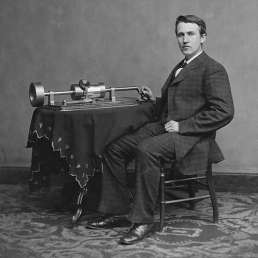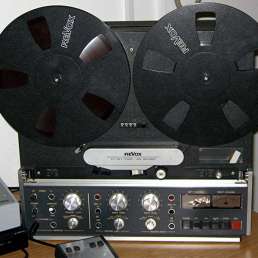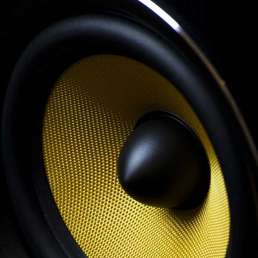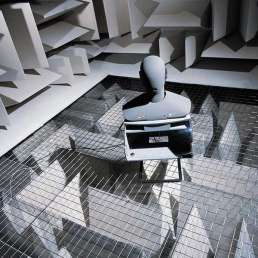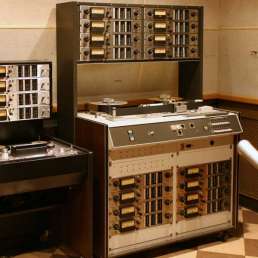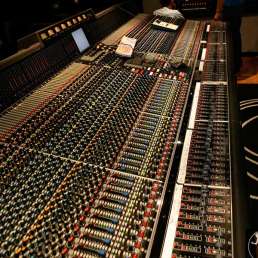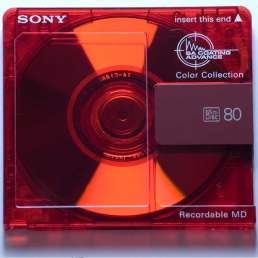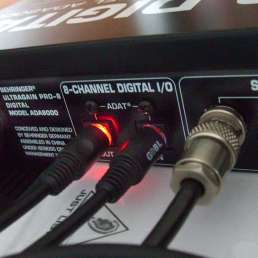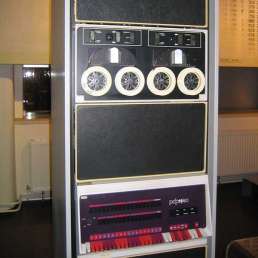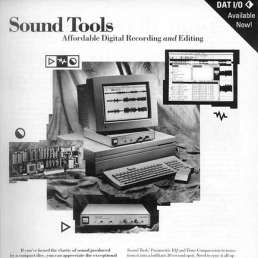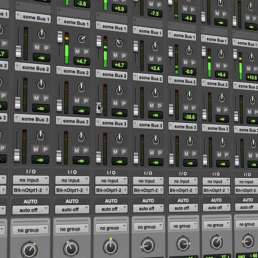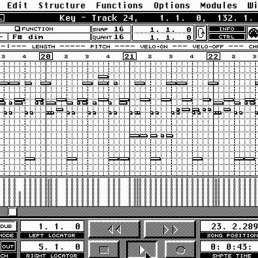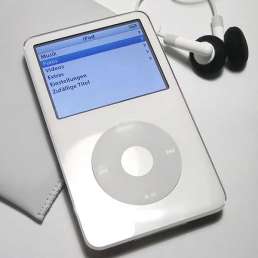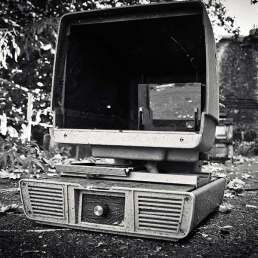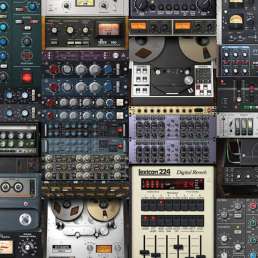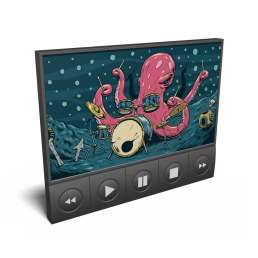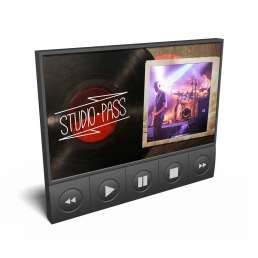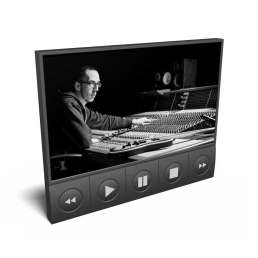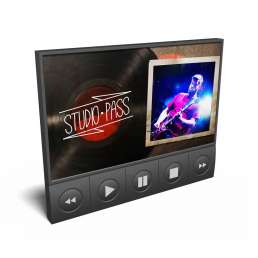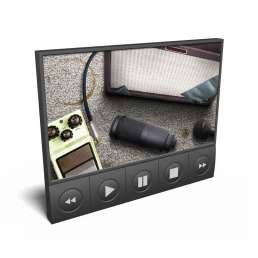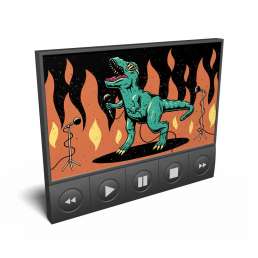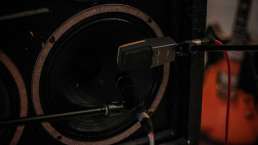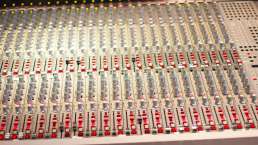Music production history and the path to our modern way of recording is characterized by many technological innovations. Be it the development of new storage media or the emergence of multi-track recorders and computers – the craft evolved constantly. Much to the delight of sound engineers and music enthusiasts, this rapid development led to ever better audio quality, but also to an increasingly complex production process.
With the widespread availability of affordable homerecording equipment, this trend has reverted back to a simpler approach. Thanks to modern technology, the sound quality of affordable recording equipment got very close to expensive top-level gear. To get some insight of the origin of your favorite hard- and software, I will summarize the music production history in short, concise paragraphs. I will not go into deepter detail on the individual historical events, but instead link to relevant, external articles.
1. The beginning (18th to mid-20th century)
The ability to record and reproduce sounds has always been a desire that many great thinkers pursued and that has shapes music production history. However, this endeavor did not really gain momentum until the end of the 19th century.
1.1 The barrel organ
Music production history begins with the appearance of the barrel organ at the beginning of the 18th century. Although the barrel organ is a musical instrument, it has, in contrast to other instruments, a predefined tone sequence which was initially “stored” on a barrel equipped with metal pins and staples. Later, at the beginning of the 20th century, a punched tape was used to store the melody instead.
1.2 The phonograph
The first milestone was the invention of the phonograph by Thomas Alva Edison at the end of the 19th century (1877). A needle attached to a sound horn recorded the sound to a cilynder that was coated with tin foil, wax, or metal. The stored sound could then be played back by also using a needle attached to a sound horn.
1.3 The gramophone and the gramophone record
The first gramophone records, already developed in 1884, were made out of metal but quickly vanished from the market due to their complex production process. With the invention of the gramphone by Emil Berliner in 1887, the real triumph of the gramophone-record started. It lasted into the 80s of the 20th century, and is currently undergoing a small revival in the form of vinyl records.
This technology also used a needle attached to a horn to record sound. This needle was guided over a wax plate instead of a cylinder and the resulting groove was etched into a zinc-disc. Later, the zinc-disc was replaced by the shellac-disc, which remained the industry standard until the introduction of the vinyl record at the end of the 1930s.
1.4 The audio tape
1.5 The microphone
With the development and the widespread distribution of the telephone in the early 20th century, the Bell Telephone Laboratorys also developed a recording technique, which replaced the acustical-mechanical method (horn – needle – carrier medium) and influenced the history of music production permanently: the microphone. Starting with the carbon-microphone, more and even better principles of sound conversion got developed. This resulted in today’s dynamic-, electret-, condenser-, ribbon– and piezoelectric-microphone.
1.6 The loudspeaker
At approximately the same time the horn, which was used to play back the recorded sound, was gradually replaced by the electrodynamic loudspeaker. Nowadays various ather loutspeaker designs are in use alongside the electrodynamic loudspeaker. The development of microphone and loudspeaker and the success of the vinyl records, which had better signal to noise ratio and a longer life span, dramatically improved the sound quality of audio recordings.
2. It’s getting interesting (1950s, 60s and 70s)
At the beginning of the 1950s, World War II military technology was used to record and produce the music of the icons of pop and rock. Only this made careers like those of the Beatles or the Rolling Stones, which left a lasting mark on music production history, possible. The ability to reproduce music cheaply and make it accessible on the mass market fueled a whole industry sector that only stumbled for the first time with the advent of the Internet.
2.1 Stereophonic sound
Already developed in 1932 by Alan Dower Blumlein, the procedure of “quasi-spatial” sound-recording and -playback came onto the market in 1958. The big advantage of record players using this so-called stereophonic-method was that they were backwards compatible and could also play back mono recordings. This system quickly established itself as industry standard and stereo is up to this date the most commonly used format for playing back music.
2.2 Multitrack recorder
Another milestone in music production history was the development of the multi-track recorder at the beginning of the 1950s. Instead of recording all the music on a single track, it was now possible to record two tracks in real-time, which were then mixed down to mono. At the beginning of the 1960s, newly developed devices could record different contents on both tracks one after another, eg. on track one the music and on track two the singing.
In the middle of the 1960s four-track machines were developed, without which albums such as “Sgt. Pepper’s Lonely Hearts Club Band” by the Beatles couldn’t have been realized in their known form. In 1967, eight-track and at the beginning of the 1970s sixteen-track recorders came out, on which more complex arrangements could be recorded in one pass. Soon after that the track count was increased to 24 tracks and tape machines could be synchronized to record 48 tracks with two linked 24-track machines.
2.3 Compact cassette
In the 1960s Philips worked on a handy tape-medium going by the project name “pocket recorder”. A wooden block that would fit into a jacket pocket specified the dimensions for the later developed recording- and playback-device. On August 28, 1963, the compact-cassette and its dedicated transistor-equipped cassette-recorder were presented. In 1965, Grundig AG launched the alternative DC-International system which was not able to compete on the market. The compact cassette also paved the way for the incredible success of Sony’s Walkman.
2.4 Mixing-consoles, equalizer und compressors
Due to the higher number of microphones used and the increasing complexity of to the production process more channels equipped with microphone-preamps were needed, which resulted in the development of large-format mixing consoles.
The increasing quality of the recording gear also made frequency overlaps and dynamic differences between the various instruments more audible which boosted the development of even finer equalizers and compressors. Initially, broadcasting technologies were used for this purpose, but in the 1960s several companies specialized in the production of mixing consoles.
Some of the pioneers in this field were e.g. NEVE, SSL and API, which still enjoy a high reputation in the professional audio sector. Many of these technologies, which were developed in the 1960s and 1970s, are still in use today in old as well as in modern gear. They are known for their sound and the musicality that they can inpart on a signal and have shaped the sound of the music of several decades.
3. The digital era (1980s and 90s)
The first small revolution in music production history the music business experienced with the advent of digital technology in the consumer sector. Music could be reproduced almost lossless and new markets were conquered thanks to globalization.
3.1 Compact Disc (CD)
Mutually developed by Sony and Philipps the “Compact Disc (CD)” was introduced to the public in 1981 at the “Funkausstellung” in Berlin. The following year industrial production started at the Polygram production facilities and in 1983 already 700 titles were available in stores. In 1988 the production spiked to about 100 million audio CDs around the globe, and from this year on CD-burning-systems also became available to the puplic.
3.2 Digital Audio Tape (DAT)
The “Digital Audio Tape (DAT)“, a magnetic storage medium, was introduced in 1987 by Sony which was designed as a replacement of the compact-cassette. For a short period a small selection of pre-recorded DAT cassettes were available commercially but the format could only gain traction in the professional audio sector. Broadcasting companies and the record industry used DAT cassettes e.g. for program exchange and archiving, since relatively large amounts of data could be stored in lossless quality.
3.3 MiniDisc (MD)
In 1991, Sony introduced the MiniDisc (MD), a magneto-optical recording medium. Until the rise of the MP3 format, the MiniDisc was a qualitatively equivalent alternative to the CD. In 2011, Sony announced to discontinue the production of MD players.
3.4 Digital mixers
In the 1980s, the concept of analog mixing consoles was slowly transferred to the digital domain and culminated in digital mixing console flagships such as the Sony Oxford OXF-R3 digital consoles, which are still in use in studios around the world. A very innovative company in the field of digital audio was Yamaha, which still produce consoles for live- and studio- applications.
A big advantage of digital mixers is that many channels can be accommodated in a small enclosure, since not every channel needs its own set of controls. As a result, the production costs can be kept low, which has a poitive effect on the retail price. Especially in livesound almost only digital mixers are in use nowadays.
3.5 Digital audio transfer
With the advent of digital mixing consoles a need for transmitting and storing digital-audio-data arose. In the professional audio sector transmission formats such as AES/EBU, ADAT and MADI became prevalent and the “Sony/Philips digital interface (S/PDIF)” established itself in entertainment electronics. Pulse-code Modulation (PCM), already developed in 1937, became the main method of storing digital audio data e.g. on CDs. The WAV file-format that is used in nearly every modern DAW is also based on PCM.
3.6 MIDI
The “Musical Instruments Digital Interface” (MIDI) was introduced in the early 1980s for the exchange of musical control information between electronic instruments such as keyboards and synthesizers. Despite of minor weaknesses, such as the slow transmission speed, MIDI has established itself as the industry-standard and has kept this status up to this day. In modern production environments it’s mostly used for controlling VST instruments and for synchronizing hardware synthesizers with the DAW.
4. Computer and the first DAWs
At the end of the 1980s, home computers slowly became a standard in private households around the globe. Musicians were now able to explore the capabilities of this new technology, enriching music history with further milestones.
4.1 Digital Editing System
First attempts to realize a “Digital Audio Workstation (DAW)” struggled with high memory prices and very limited computing power. Despite these drawbacks, Soundstream launched the Digital Editing System in 1977, which enabled users to edit audio-data digitally. This system could be pretty much called the first DAW.
4.2 First editing software
4.3 Pro Tools
In 1991, Digidesign released the first Pro Tools, which needed additional dedicated hardware to simultaneousely process up to four audio tracks. Pro Tools was also the reason for many professional recording studios to switch to a digital editing system. During this time various other manufacturers also released hardware assisted DAWs for Windows and Mac.
4.4 Cubase VST
In 1996 Steinberg introduced “Cubase VST“, which made it possible to process up to 32 digital audio tracks without the need of external DSP hardware. The software interface was modeled after analog mixing consoles that used additional external effect-racks – this layout of the interface soon got imitated by other DAW manufacturers. At the same time the VST-protocol was introduced, which established itself as the quasi-standard for the programming of plugins.
4.5 MP3
Another milstone in music production history happend in 1982 when the Frauenhofer Institute started to develop the MPEG-1 Audiolayer III (Mp3) format – one of the most influental developments in music history. It’s a compression format based on psychoacoustics that can drastically reduce the size of audio files. Devices such as the iPod and the advent of the internet fueled the success of the MP3 format. Since it’s a lossy audio-data compression-format, it has little to no significance in the sector of professional audio and gets used only as a consumer product or in music-streaming.
5. The modern homestudio
Music production history has given rise to many groundbreaking inventions that make it easy nowadays to record music at home. Even with a small budget, high quality recordings can be produced in a small homestudio and, thanks to the internet, music can be made accessible to millions of listeners worldwide.
5.1 Laptop / PC
The first important component in every homestudio is a laptop, desktop PC or tablet that has enough computing power to simultanousely play back several audio tracks and their applied effects. Your computer should at least have a USB 2.0 port to connect a simple audio interface, a modern multicore processor and a minimum of 4GB RAM, so that even modern VST instruments and plugins will work flawlessly.
5.2 Audio-interface / soundcard
The next crucial element is the audio-interface or soundcard. Depending on the connectivity options of your computer, you can use a USB 2.0/3.0, Firewire or Thunderbolt interface. Each connection has certain advantages, which I will examine in a separate post. In professional recording studios also PCIe interfaces are in use. The audio interface should at least have one microphone input with a preamp and one instrument input.
5.3 The microphone
The microphone converts the vibrations of the air, that are generated by sound source, into electricity. At the moment of conversion the highest possible resolution is needed and therefor, the microphone needs to be high grade. The good thing is that the credo “good=expensive” is not true anymore. Nowadays, there is a huge selection of affordable, high-quality microphones available.
5.4 Speaker / headphones
At the end of the signalchain the electrical voltage must be converted back into vibrations of the air. This task is getting done by loudspeakers, so-called studio monitors, or good studio headphones (no iPhone headphones). In this context, please DO NOT forget about room acoustics when using loudspeakers. Similar to microphones, good monitors and headphones are also very affordable nowadays.
5.5 Software
Mixing-consoles and countless outboard gear are the tools of yesterday – nowadays the software defines the sound of your recordings and shapes your production workflow.
5.5.1 DAW
First, you will need a DAW to edit and later mix your recorded tracks. There are several DAWs available on the market, which all have similar capabilities but also have unique strengths and weaknesses.
5.5.1 Plugins
Every DAW comes with a set a stock-plugins, that cover a wide range of recording- and mixing-applications. There are also countless third-party manufactureres who develop plugins for special applications or offer emulations of vintage gear. With this third-party plugins you can enhance every DAW and create and refine your own workflow.
5.5.2 Software-Instrumente
Software instruments (virtual instruments) are usually the cornerstone of productions of many songwriters and producers. They are often based on samples (drums, piano, orchestra) or are emulations of old hardware units (synthesizers, drummachines). DAWs like Cubase usually come with a small selection of software instruments, so you can start making music immediately. Like with plug-ins there is also a large number of third-party software available.
Conclusion
In modern homestudios the technological breakthroughs of the last 150 years are combined in just a few devices. Composing and producing music is as easy as never before and with the knowledge of where this technologies originated, you can expand your own horizon as a producer and musician. Be inspired by long forgotten applications for certain plugins or effects you didn’t know about yet and develop new, creative ideas on how to use these tools in a different manner. It can also be a quite satisfying experience to delve into the music of different eras and discover something new for yourself.
If you have other questions about homerecording feel free to browse through all my homerecording posts.
Header-image: Google image search
Sources: Wikipedia.org (2017)
Relevant products
Similar posts
The 4 main music production disciplines explained
For people who are getting started with music, production terms like mixing, mastering, recording,…
What is a pre-production and do I need it for my record?
The pre-production is the one part in music production that many musicians do not know much about.…
Things you should know before recording in a studio
Even nowadays, one of the main goals of many bands is to record their music in a professional…
What is audio editing and is it really necessary?
You've carefully recorded all your instruments with the best possible audio quality and you've put…
Mixing audio – What is mixing and can I do it myself?
Thanks to modern technology, almost anyone can produce their music at home - even with a low-budget…
What is mastering and do I really need to master my tracks?
Nowadays songs get mixed on headphones, music is consumed via cellphone speakers but also played on…

